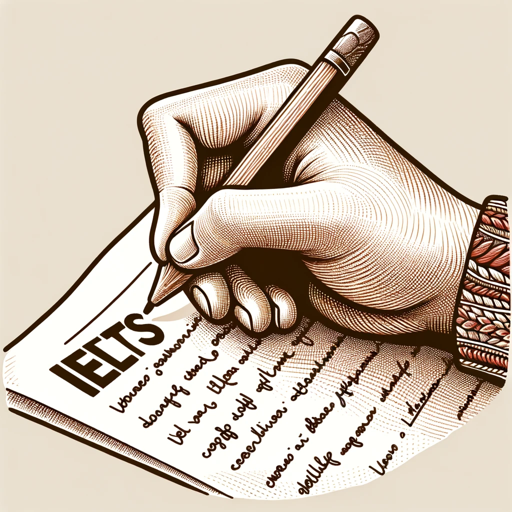IB English A Lang/Lit-AI IB English A Lang/Lit Helper
AI-Powered Assistance for IB English Success
Your SKLSUPPLYAI companion to navigating complicated texts in International Baccalaureate (IB) English A Lang/lit (Please specify whether you are studying at HL or SL)
Can you help me understand the theme of identity in 'The Great Gatsby'?
I'm struggling with text analysis. Could you provide a practice question?
How does context influence the interpretation of a literary work?
I need tips for writing a comparative essay on two poems. Can you assist?
Related Tools

My English Dictionary
AI English Teacher designed to help you learn and understand English words and phrases comprehensively.

Paper Interpreter (International)
Automatically structure and decode academic papers with ease - simply upload a PDF or enter a URL!

IELTS Writing
Helps with IELTS writing tasks, including essay, letter, and academic writing. Fixes grammar issues. Simply paste your task and answer to receive expert guidance.

IELTS ✅
Evaluation of IELTS essay, letter and academic writing. Grammar correction.
IB Business Management Companion
Your SKLSUPPLYAI companion helping you with everything to do with International Baccalaureate (IB) Business Management (Please specify if you are doing HL or SL)

IELTS Writing Mentor
Get personalized IELTS writing assistance, focusing on in-depth analysis and enhancement of both Task 1 and Task 2. Simply paste your task and essay to receive expert guidance.
20.0 / 5 (200 votes)
Introduction to IB English A: Language and Literature
The IB English A: Language and Literature course is designed for students in the International Baccalaureate (IB) Diploma Programme, typically between the ages of 16 and 19. This course explores the complex nature of language, focusing on its role in communication, its aesthetic dimensions, and its capacity to shape both individual perspectives and the world. The curriculum emphasizes critical engagement with a wide range of texts from different periods, styles, and cultures, and encourages students to consider their own interpretations as well as those of others. For example, students might analyze how a novel's use of language reflects its cultural context, or how a media text manipulates visual elements to convey meaning. The course is structured to develop a broad set of skills, including analysis, interpretation, and evaluation, alongside fostering a lifelong interest in language and literature.

Main Functions of IB English A: Language and Literature
Textual Analysis
Example
Students analyze unseen texts during Paper 1 of the external assessment, focusing on how language, structure, and stylistic features contribute to meaning.
Scenario
In a real-world scenario, a student might be presented with an excerpt from a speech and asked to dissect the rhetorical strategies used by the speaker to persuade the audience. They would examine elements such as tone, diction, and syntax to understand the impact on the listener.
Comparative Literary Study
Example
In Paper 2, students compare two literary works, considering how each addresses a common theme or issue.
Scenario
For instance, students might compare how two novels from different cultural backgrounds deal with the theme of identity. They would explore how each author uses narrative techniques, character development, and setting to convey their perspective on this theme.
Oral Communication Skills
Example
The Individual Oral, an internal assessment, requires students to prepare a spoken response comparing a literary work with a non-literary text on a shared global issue.
Scenario
A student might analyze how a poem and a political cartoon both address the issue of social inequality, discussing the different ways these texts communicate their messages and the impact on their respective audiences.
Ideal Users of IB English A: Language and Literature
IB Diploma Programme Students
These are students enrolled in the IB Diploma Programme, particularly those who have a strong interest in language, literature, and cultural studies. They benefit from the course's emphasis on critical thinking, global perspectives, and analytical skills, which are essential for success in higher education and beyond.
Educators and Teachers
Teachers who guide students through the IB English A: Language and Literature course are another key user group. They use the curriculum to develop lesson plans that help students engage deeply with texts and develop their analytical abilities. The course provides a framework for educators to foster critical thinking and appreciation for diverse literary forms and cultural perspectives.

How to Use IB English A Lang/Lit
Visit aichatonline.org for a free trial without login.
Start by accessing the platform where IB English A Lang/Lit is available. The website offers a free trial, eliminating the need for ChatGPT Plus or any login credentials.
Understand the Course Structure.
Familiarize yourself with the curriculum components, including 'Readers, Writers and Texts,' 'Time and Space,' and 'Intertextuality: Connecting Texts.' These form the foundation of the IB English A Lang/Lit course.
Utilize the Practice Questions and Sample Responses.
Engage with a variety of practice questions that reflect the exam formats, such as guided textual analysis and comparative essays. Analyze sample responses to understand the expectations.
Interact with the AI for Personalized Feedback.
Submit your answers to receive AI-generated feedback, which will guide you in refining your analytical and evaluative skills according to IB standards.
Review the IB Assessment Model.
Understand how different assessment components, such as the HL essay, individual oral, and written coursework, are evaluated to maximize your performance in the course.
Try other advanced and practical GPTs
TaskSpecific-InteractiveSystem
AI-powered solutions for precise tasks

Pixel Art +
AI-Powered Pixel Art Generation

URL Crawler
AI-Powered Web Content Extraction Made Easy

PPC Pro | Amazon Advertising Specialist
AI-powered Amazon PPC strategy

Dream Interpreter
AI-powered dream analysis and visualization.

Video GPT
AI-Driven Video Creation for All

City Tour Guide
AI-Powered Custom City Tours

Gym Workout
AI-powered fitness coaching and workout planning

Expert Financial Analyst AI
AI-Powered Financial Insights at Your Fingertips.

Apresentação em Slides Completa - Srtª Flash
AI-driven slide presentations made simple.

Chef de projet GPT+
Empowering Projects with AI Precision

Linkedn EXPERT Post Writer
AI-powered LinkedIn posts that engage

- Exam Preparation
- Essay Writing
- Text Analysis
- Language Skills
- Literary Studies
FAQs about IB English A Lang/Lit
What is the primary focus of the IB English A Lang/Lit course?
The course emphasizes the exploration of the complex and dynamic nature of language. It involves studying various texts, developing skills in analysis, interpretation, and communication, and understanding the relationship between language and culture.
How are students assessed in the IB English A Lang/Lit course?
Assessment includes both external and internal components, such as a guided textual analysis, a comparative essay, an HL essay, and an individual oral. Each component evaluates specific skills like analysis, evaluation, and communication.
What types of texts are studied in this course?
Students engage with a wide range of texts across various media and forms, from different periods, styles, and cultures. These include literary works, non-literary texts, and performances.
How can I improve my performance in the IB English A Lang/Lit course?
Regular practice with past paper questions, seeking feedback, engaging in group discussions, and analyzing sample responses are effective strategies for improving performance.
What is the difference between the SL and HL levels in this course?
The HL level involves more extensive study, with additional hours dedicated to each syllabus component. The HL essay is also a requirement that is not included in the SL assessment.